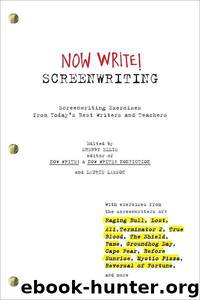Now Write! Screenwriting: Screenwriting Exercises From Today's Best Writers and Teachers by Sherry Ellis & Laurie Lamson

Author:Sherry Ellis & Laurie Lamson [Ellis, Sherry & Lamson, Laurie]
Language: eng
Format: epub
Tags: Reference
ISBN: 9781585428519
Google: yXs7ao1h-4cC
Amazon: B00475AYBE
Barnesnoble: B00475AYBE
Goodreads: 10053384
Publisher: Tarcher
Published: 2010-01-02T00:00:00+00:00
COLLEEN MCGUINNESS
Some Things Are Better Left Unsaid
COLLEEN McGUINNESS’S television credits include the NBC medical drama Mercy, Miss Match, North Shore and the Steven Spielberg- produced On the Lot. She has a number of studio films in development, including an adaptation of the Italian film L’UOMO PERFETTO (THE PERFECT MAN).
There’s a Hall and Oates song with the above title. It’s also a useful mantra to remember if you’re a screenwriter. One of the jobs of a screenwriter is to provide texture and depth to each scene so that the audience can dig deep and discover what it is a character really wants as opposed to what he says he wants. What is a character trying to hide? What is the subtext? What is left unsaid?
When I completed my first screenplay, a trusted friend of mine read it and complimented me on its subtext. I thanked him but barely knew what he meant. Subtext? What was that? Did I really have it in my script? I hadn’t purposefully added any subtext, but it was a character-driven piece, and naturally these characters were not always forthright about what they wanted. I decided my use of subtext here was just beginner’s luck. While writing other projects, however, where mandatory plot and event were initially the focus, I was forced to become aware of subtext and how/where to include it. I had to make sure that each scene I wrote had more than one color to it. There is always the event of the scene, yes, but what lies beneath is often the most crucial aspect of the story.
There are lots of ways to work with subtext in a screenplay. Sometimes it’s through dialogue: People say one thing and mean another. Or maybe it’s through setting: The characters don’t have to say much, but their surroundings say it all. Almost always, though, it comes down to behavior. What is the character doing that reveals what his or her true intention is?
It helps to look at a scene in three ways: (1) What is the event of the scene? (2) What is the subtext? (3) How is that subtext achieved and fleshed out?
Let’s look at a very simple example from one of my favorite movies: PRETTY IN PINK. In a pivotal scene, Blayne (Andrew McCarthy) walks into the record store where Andie (Molly Ringwald) works. The event of the scene is that he buys a record from her. The subtext: He likes her and wants to ask her out. To take it further, you could note that he chooses to flirt with her on her turf, perhaps to make her more comfortable or maybe to learn more about her.
In the second part of the scene, Duckie (Jon Cryer) pulls Andie away from Blayne when he sets off the fire alarm (the event of the scene). As a result of this interruption, Blayne leaves before they finish their conversation. There is more subtext to mine from these events: Does Blayne’s exit mean he is not yet fully
Download
This site does not store any files on its server. We only index and link to content provided by other sites. Please contact the content providers to delete copyright contents if any and email us, we'll remove relevant links or contents immediately.
Call Me by Your Name by André Aciman(20350)
Ready Player One by Cline Ernest(14494)
How to Be a Bawse: A Guide to Conquering Life by Lilly Singh(7360)
Wiseguy by Nicholas Pileggi(5648)
The Kite Runner by Khaled Hosseini(5061)
On Writing A Memoir of the Craft by Stephen King(4847)
Audition by Ryu Murakami(4822)
The Crown by Robert Lacey(4710)
Call me by your name by Andre Aciman(4599)
Gerald's Game by Stephen King(4556)
Harry Potter and the Cursed Child: The Journey by Harry Potter Theatrical Productions(4427)
Dialogue by Robert McKee(4305)
The Perils of Being Moderately Famous by Soha Ali Khan(4156)
Dynamic Alignment Through Imagery by Eric Franklin(4099)
Apollo 8 by Jeffrey Kluger(3621)
Seriously... I'm Kidding by Ellen DeGeneres(3564)
The Inner Game of Tennis by W. Timothy Gallwey(3557)
How to be Champion: My Autobiography by Sarah Millican(3544)
Darker by E L James(3463)
